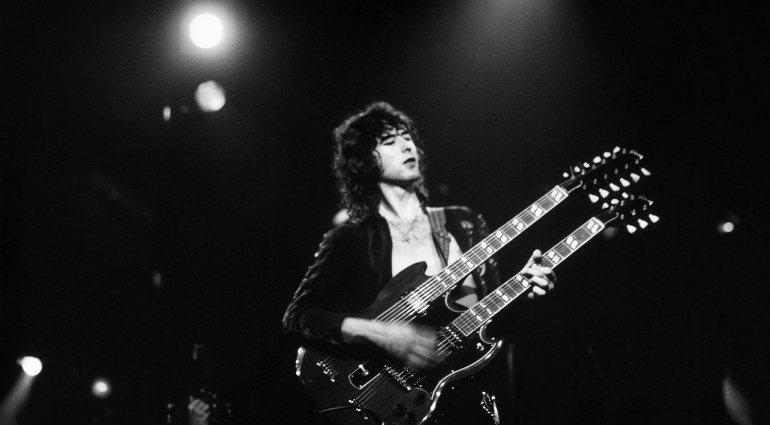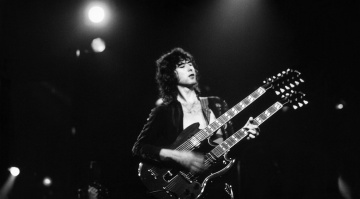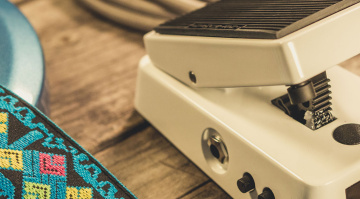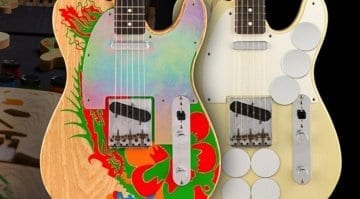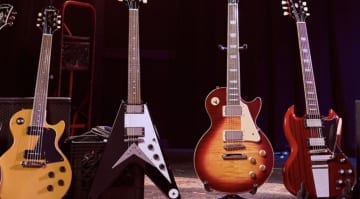Jimmy Page’s Gear – The Greatest Guitarists of All Time
What Does the Led Zeppelin Frontman Use?
If there’s a gray eminence among guitarists, it’s probably Jimmy Page. His gear ranges from painted Telecasters to the legendary “Number One” Les Paul and the iconic double-neck SG. He has created his own musical universe out of blues, folk, and hard rock. As a guitarist, producer, and founder of Led Zeppelin, Page is more than just a player – he’s a researcher, tinkerer, sound painter, and living legend. In this article, we’ll examine the guitars, amps, and effects that comprise Jimmy Page’s gear and how we can incorporate them into our own setups.
All About Jimmy Page’s Gear
Jimmy Page’s Gear: Style and Significance
Jimmy Page is considered one of the most influential guitarists of all time, and not just because of his riffs. He understood early on that the studio could be an instrument in its own right, and he left his mark on one or more generations.
As a session musician in the early 1960s, he played on hundreds of recordings (including with the Rolling Stones, the Who, the Kinks, and Donovan) before joining the Yardbirds in 1966 (initially on bass) and founding Led Zeppelin in 1968.
To me, Jimmy Page’s style is characterized above all by his open tunings (open G, DADGAD, and open D) and his clear blues influences. Add to that extreme dynamic contrasts (intro versus main riff; see the linked video for “Ramble On”) and tremendous improvisational talent, and there you have it. Nothing could be simpler, right?
The Guitars: From Telecaster to Les Paul
I can’t start without talking about the legendary guitars in Jimmy Page’s gear. As someone who can’t be pigeonholed into a particular category or manufacturer – Gibson or Fender really doesn’t matter to him – this review is really fun and will leave you wanting more (GAS, here we go again).
Fender Telecaster “Dragon”
The story begins with a gift. In 1966, Jeff Beck gave Jimmy Page a Fender Telecaster, which he later lovingly painted and named “Dragon.” Read the full story on the Fender website: Dragon Slayer: The Magical Mystery of Jimmy Page’s Painted Telecaster.
This guitar played a leading role on Led Zeppelin I, on songs such as “Good Times Bad Times,” “Dazed and Confused,” and “Communication Breakdown.” The legendary solo in “Stairway to Heaven” also comes from the Tele.
The Dragon has all the features of a classic Telecaster: single coils, an ash body, and a maple neck – everything you need for clear but biting tones.
Even though the original Dragon no longer exists due to the tumultuous life of a rock star, Fender has done everything in its power to keep the legend alive. While the paint job is certainly debatable, the sound heard on the first Zeppelin album is not.


Gibson Les Paul Standard 1959 “Number One”
Hardly any guitarist is more closely associated with the Les Paul than Jimmy Page. His famous 1959 Standard, which he affectionately called “Number One,” became his acoustic signature. It is currently on display at the Metropolitan Museum of Art.
A 1959 Les Paul is spectacular enough in itself, but Page’s model is truly one of a kind. He had it modified by a technician. It was fitted with push-pull potentiometers for coil splitting, out-of-phase circuits, and reverse polarity between the pickups to bring more life to the instrument.
In combination with his Marshall setup, Number One defined what is now referred to as “the Led Zeppelin sound.” Songs like “Whole Lotta Love” and “Black Dog” thrive on this dense, raw, incomparable sound.
Gibson (and its subsidiary, Epiphone) owes us a signature version – maybe something will come along!




Gibson EDS-1275 Doubleneck
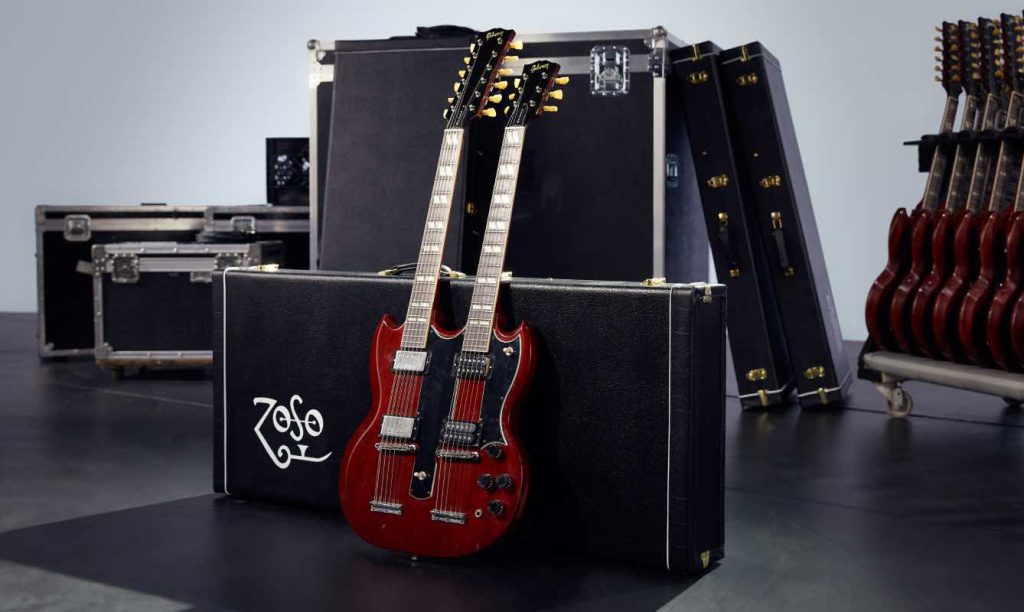
Hardly any other instrument embodies the legendary status of Jimmy Page and Led Zeppelin more than the red Gibson EDS-1275 Doubleneck guitar. With two necks and twelve and six strings, it produced performances that went down in music history.
Page primarily used it live for “Stairway to Heaven,” but also for epic live versions of “The Rain Song” and “The Song Remains the Same.”
And: The double neck was functional, not just for show. Page could switch fluidly between arpeggios and power chords without switching guitars. The sound is surprisingly balanced – powerful but not overloaded. Combined with light reverb and echo effects, it created a spatial sound that was perfect for the big Zeppelin stages, together with Jimmy Page’s gear.
If you’re looking for an affordable alternative today, check out the Harley Benton DC-Custom 612 Cherry. With the right modifications, you can start recreating Jimmy Page’s gear arsenal and sound.


Amplifier: British Power with American Warmth

Jimmy Page, Led Zeppelin’s sound architect, made his choice of amplifiers an integral part of his role. Unlike many of his contemporaries, Page never relied exclusively on one model. Instead, he used a variety of amps in the studio to give each song its own sonic identity.
His live sound, however, was uncompromisingly British: loud, dynamic, and direct. His studio recordings, however, were often subtle and sometimes surprisingly “small” in concept – a prime example of the saying: “Greatness comes from space, not volume.”
Supro Thunderbolt
The unassuming Supro Thunderbolt is considered the secret hero of Led Zeppelin’s first album. This small, 1×15” 35-watt combo delivers the raw, smacking overdrive familiar from songs like “Communication Breakdown.”
Unlike the often-cited open Marshall, the Supro does not deliver a powerful sound. Rather, it delivers a compressed, focused tone that harmonized perfectly with the recording methods of the time and the rest of Jimmy Page’s gear. It’s overdriven but controlled. “Studio crunch” in the best sense of the word.
Many people still underestimate the fact that Led Zeppelin I was recorded almost exclusively with this small amp – no half stack, no full stack. Today, the manufacturer offers a range of modern amps with a retro character. In my opinion, the Supro 1696RT Black Magick Rev Combo captures Page’s sound wonderfully, even though it was developed with Lenny Kravitz instead of Page for Jimmy Page’s gear.

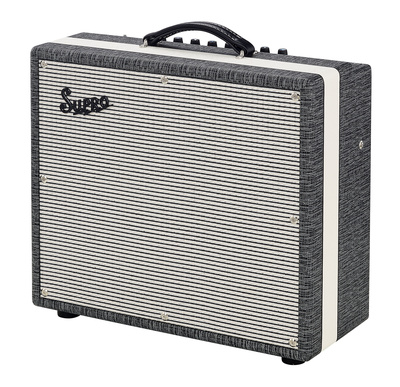
Marshall Plexi & Hiwatt Custom 100 – The Giants of the Stage
Jimmy Page had to take a different approach live. When you’re filling stadiums, you need reserves – and lots of them. He chose the biggest names in British amp culture: The Marshall Super Lead 1959 Plexi and the Hiwatt Custom 100.
In this setup, the Marshall provides the rock foundation while the Hiwatt delivers assertiveness, clear highs, and headroom for complex dynamics. These two amps shaped Led Zeppelin’s live sound for years, providing a powerful yet clear sound.
You can especially hear the interplay of the two amps in songs like “Heartbreaker” or “Whole Lotta Love.”
Effects: Tone Bender, Echoplex, and Wah – the Sound of the Mystic
Effects played a crucial role for Jimmy Page, even if they were never really the focus.
The centerpiece was the Sola Sound Tone Bender MKII Fuzz, a classic germanium-based circuit that produced a slightly muddy yet magically organic distortion sound. In songs like “How Many More Times” and “Heartbreaker,” you can immediately hear the character of this old circuit. The best approximation today is the British Pedal Company Vintage Series OC81D Fuzz – a great piece of equipment!

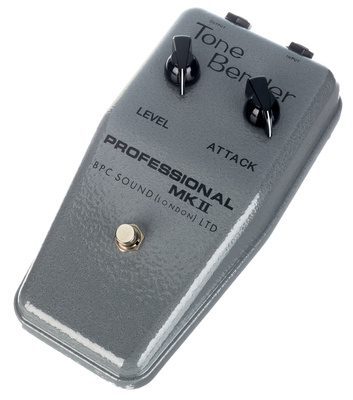
To create spatial depth, Page used a Maestro Echoplex EP-3, an analog tape echo that extended the sound without distorting it. When combined with the Les Paul, it produced a slightly reverberant, vibrating tone that truly shines in ballads like “Since I’ve Been Loving You.” Today, the Catalinbread Belle Epoch BOS comes pretty close to this sound, albeit without tape.


Of course, the Vox Wah-Wah is a must-have. Page used it sparingly yet purposefully, as a means of expression rather than an effects extravaganza. If you’re looking for a modern version, the Vox V845 Wah-Wah remains the best choice.

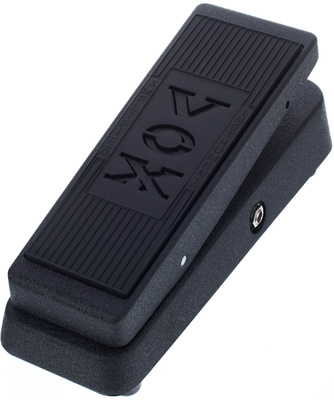
How to Replicate Jimmy Page’s Gear
Jimmy Page’s sound is not tied to a particular amp or guitar, yet some clear constants can still be reproduced today. You don’t have to spend a fortune on vintage equipment or perform at the Royal Albert Hall to achieve it.
The basic principles are transparency, dynamics, and space. His tone thrives on the interaction between attack, volume, and room acoustics. With the right combination of equipment and technique, this can be achieved surprisingly well.
Jimmy Page’s Gear: Guitars
To get closer to the Page sound, go for a Les Paul with classic humbuckers. It’s important that the guitar responds, meaning it should react audibly to playing strength and touch. 50s wiring is a welcome electronic modification.
The perfect foundation for the Page Paula sound is, of course, a classic Gibson Les Paul Standard ’50s in a beautiful vintage honey burst finish. If you’re looking for something more affordable, the “Inspired by Gibson Custom” models from Epiphone are a good option.




If you’re into the old Zeppelin sound, you’ll need to go for a Fender Telecaster. Either the signature model or the equally excellent Vintera II version of the 60s Telecaster.

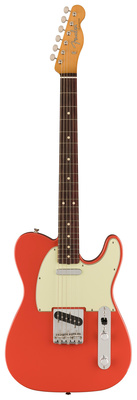


Jimmy Page’s Gear: Amplifiers
In the studio, Page used small combos, but for live performances, he used large half stacks. For everyday use, you need something in between with enough headroom but not excessive volume.
I currently really like the Studio Vintage SV20H for British Marshall sounds, but it’s a loaner that I should probably return soon.
If you want something smaller, check out the Supro Delta King 10 Combo. You can’t get much closer to a classic Supro combo sound – or a cheaper one – these days.

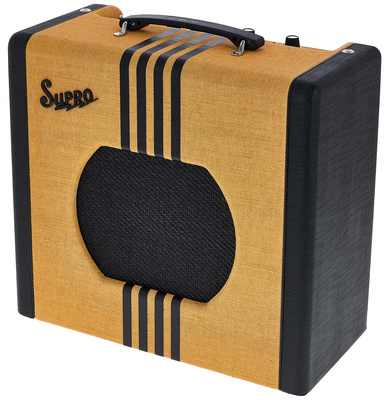

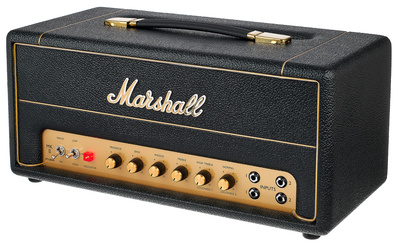
It’s important to set the selected amp to operate just before saturation. Set the gain to around 6 and the volume to your liking. Then, see what happens. Any remaining distortion comes from the velocity, or a slight fuzz if necessary.
Jimmy Page’s Gear: Effects
Speaking of fuzz: The British Pedal Company Vintage Series OC81D Fuzz, mentioned above, is an awesome piece of equipment, but at just over €230, it’s expensive. If you’re looking for something more affordable, the Electro-Harmonix Bender Royale Fuzz Black is a great option.
Add a nice echo, such as the Catalinbread Belle Epoch, and a Vox Wah to the board, and everything will fit together perfectly.





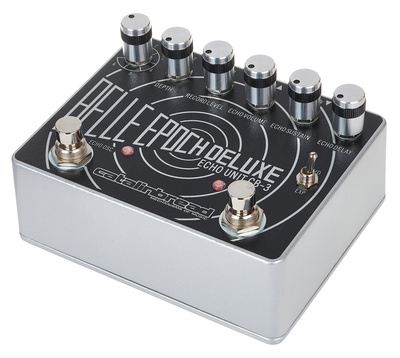
Conclusion to Jimmy Page’s Gear

Jimmy Page’s gear has always been the foundation of his sound. It has never been luxurious; it has always been functional, serving as a means to an end and bringing songs to life. The building blocks are the Telecaster, Les Paul, Supro, Hiwatt, and Marshall, but the foundation is technique, inventiveness, and sheer genius.
And if the inventors of the time machine are reading this: There was a time when Jimmy Page, Robert Plant, John Paul Jones, and John Bonham played together in a band and performed live. Take. Me. There!
This article was originally written by Jan Rotring for GEARNEWS.
*Note: This article about Jimmy Page’s gear contains affiliate links that help finance our site. Rest assured, the price for you always remains the same! If you purchase something through these links, we receive a small commission. Thank you for your support!


 4,0 / 5,0 |
4,0 / 5,0 | 